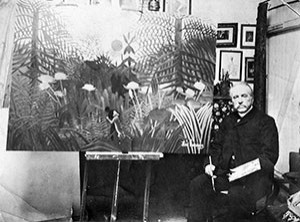Born 1884, Laval, France
Died 1910, Paris, France
Despite his nickname, “Le Douanier,” Henri Rousseau actually worked as a municipal inspector, not a customs officer, before his 1884 retirement. Self-taught as an artist, he made his debut two years later at the Salon des Indépendants, a nonjuried exhibition that would become a key venue for the avant-garde. Soon his paintings were championed by a younger generation of artists, who prized his directness of manner, visionary imagination, formal daring, and apparent lack of sophistication. After Rousseau’s death, Wilhelm Uhde commemorated him in a monograph and featured his paintings in the exhibition Les peintres du Coeur Sacré (1928).
Rousseau became central to the early history of modernism in the US. The artist Max Weber organized a posthumous presentation of his work at Alfred Stieglitz’s 291 gallery in 1910, which was followed by shows at Marius de Zayas’s gallery and the Whitney Studio Club in the 1920s. Rousseau appeared in Alfred Barr’s landmark exhibitions at MoMA, Cubism and Abstract Art (1936), Fantastic Art, Dada, Surrealism (1936), and Masters of Popular Painting (1938). In 1939 Barr acquired Rousseau’s Sleeping Gypsy (1897) for the museum with the support of Olga Guggenheim. Beginning in 1941, the painting took pride of place in the gallery devoted to “Modern Primitives,” for Barr considered Rousseau to be one of the five founders of modern art. While the Parisian avant-garde celebrated the exotic motifs and deliberately primitivizing style of his jungle paintings, American audiences were equally enamored of his landscapes, portraits, and urban scenes.
In Rendezvous in the Forest a refined screen of grass, leaves, and branches obscures a romantic assignation. The lovers, clad in archaic costume, blend into their environs, with figure and ground rendered so minutely as to undercut the illusionism of the scene. Young Girl in Pink evokes the vernacular form of carte de visite photography, as the figure dominates the landscape and the starched pleats of her dress stiffly echo the tree trunks in the background. Rendered in a similarly flat and polished manner, Tropical Forest with Monkeys conjures a highly theatrical, fantastic scene and provides an occasion for the arrangement of form unbound by the rules of naturalistic representation.
Jenevive Nykolak
Rich, Daniel Catton. Henri Rousseau. New York: The Museum of Modern Art, with the Art Institute of Chicago, 1946.
Shattuck, Roger, et al. Henri Rousseau. New York: The Museum of Modern Art, 1985.
